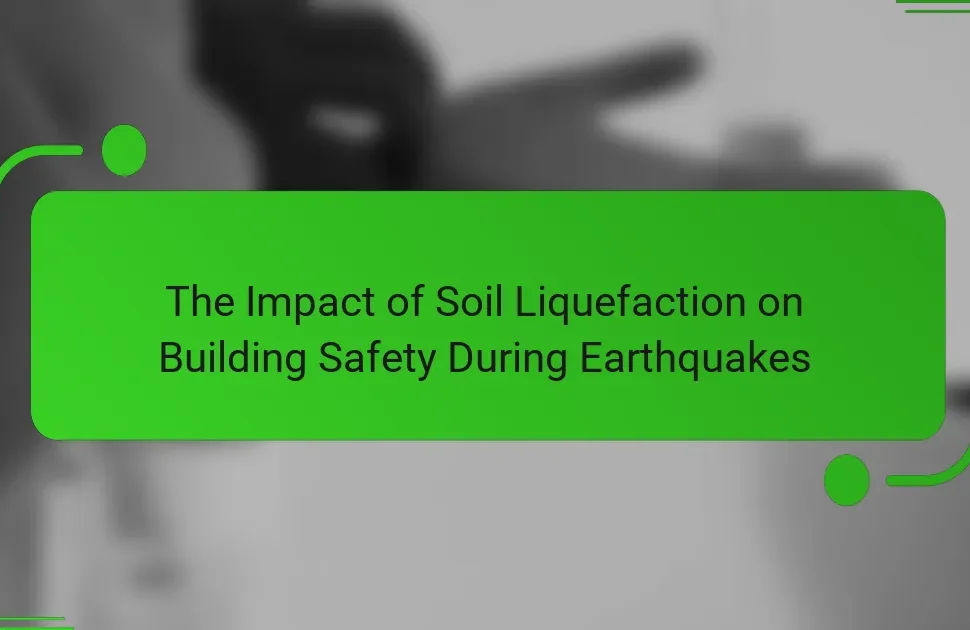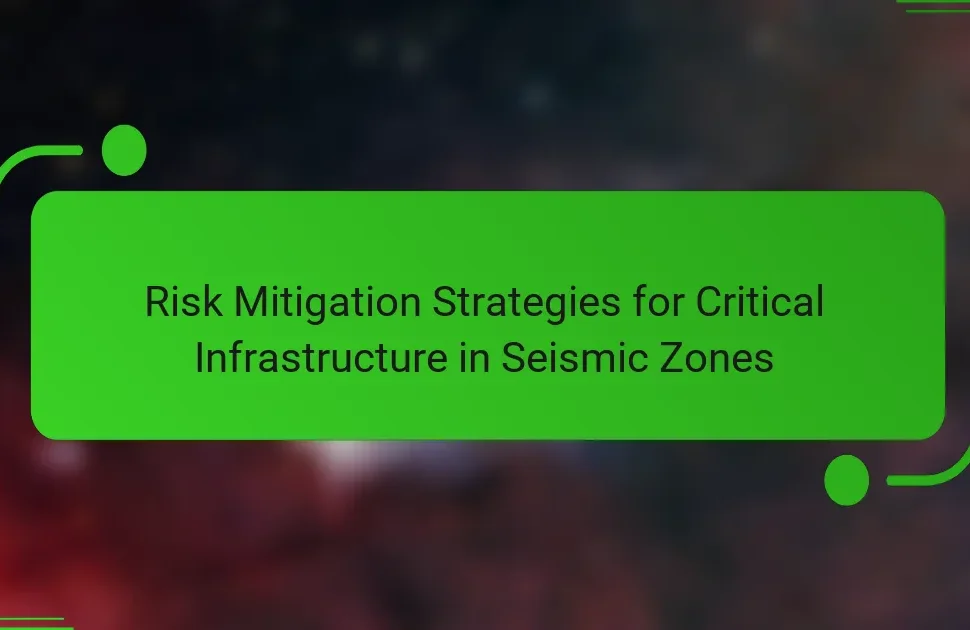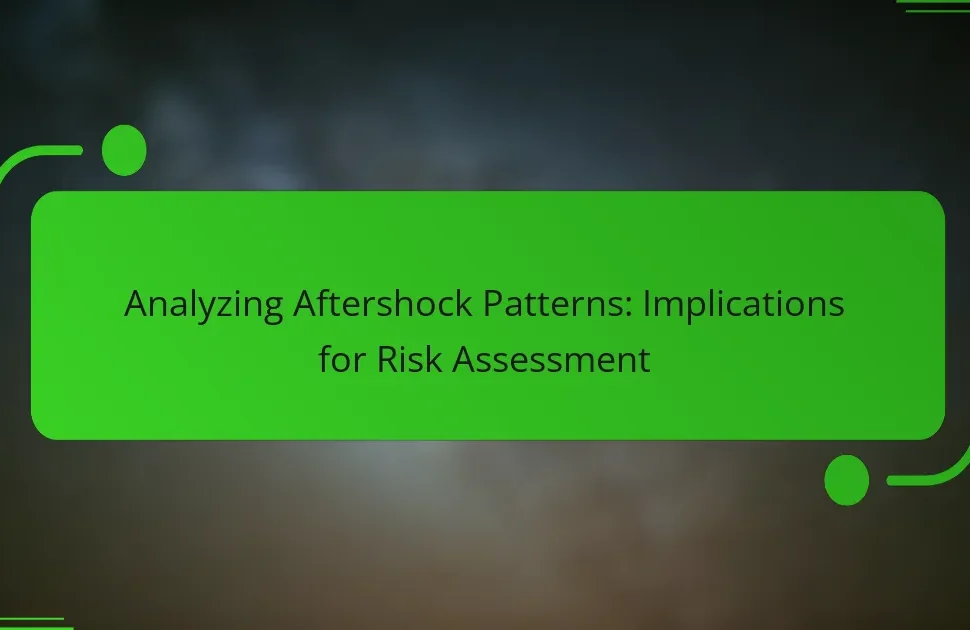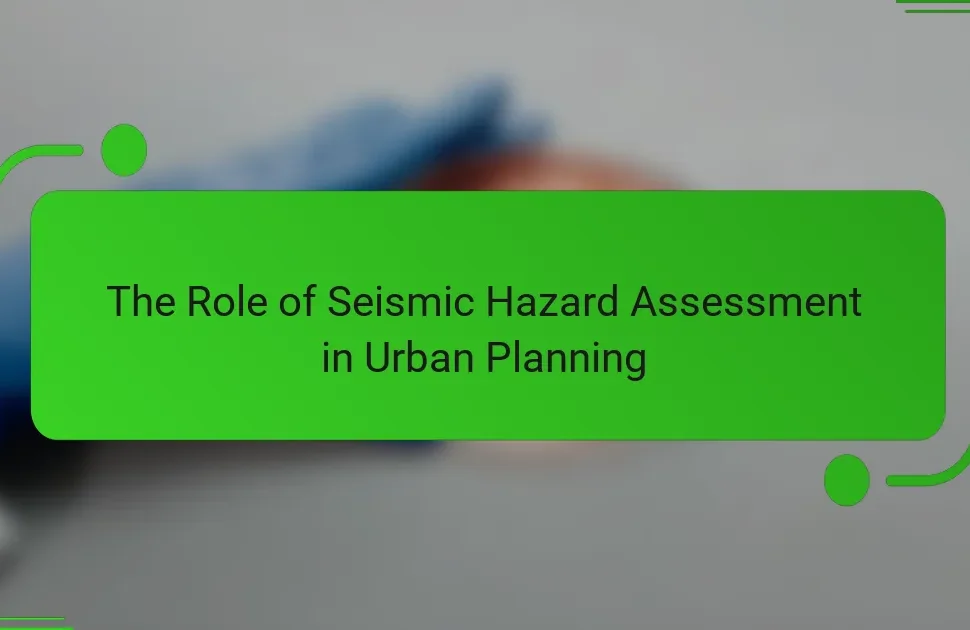Earthquake Risk Evaluation assesses the potential impact of earthquakes on structures and populations by analyzing historical seismic data and predicting future occurrences. This process identifies vulnerable areas and informs disaster preparedness strategies, focusing on geological conditions, building codes, and community resilience. Utilizing historical data, statistical models, machine learning algorithms, and physical models, researchers can predict earthquake risks more accurately. Effective evaluations can significantly reduce casualties and economic losses, as evidenced by resources such as the United States Geological Survey (USGS) seismic hazard maps, which aid urban planning and construction efforts.
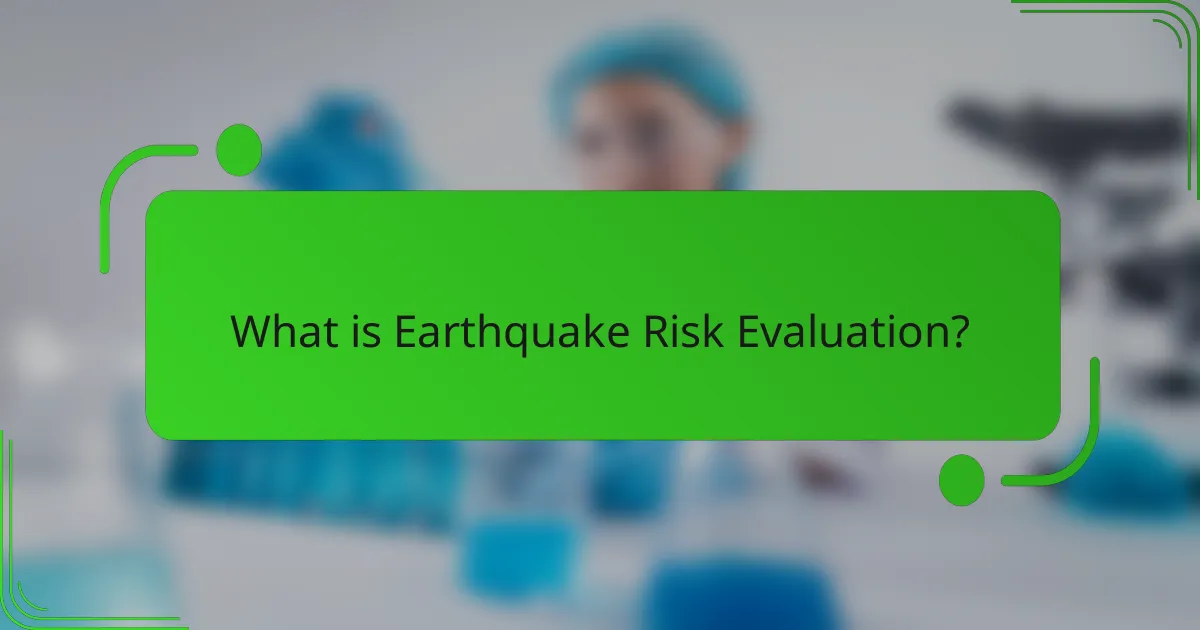
What is Earthquake Risk Evaluation?
Earthquake Risk Evaluation is the process of assessing the potential impact of earthquakes on structures and populations. It involves analyzing historical seismic data and predicting future earthquake occurrences. This evaluation helps identify vulnerable areas and informs disaster preparedness strategies. It typically includes examining geological conditions, building codes, and community resilience. Studies show that effective earthquake risk evaluation can significantly reduce casualties and economic losses. For instance, the United States Geological Survey (USGS) provides detailed seismic hazard maps to guide urban planning and construction.
Why is it important to evaluate earthquake risk?
Evaluating earthquake risk is crucial for minimizing damage and saving lives. Understanding the likelihood of earthquakes helps in planning and preparedness. Accurate risk assessment allows for the design of buildings that can withstand seismic activity. Historical data reveals patterns that inform future predictions. For instance, the 1906 San Francisco earthquake led to changes in building codes. These codes aim to improve structural integrity in earthquake-prone areas. Moreover, risk evaluation supports emergency response planning and resource allocation. Communities that assess earthquake risk can implement effective mitigation strategies.
What are the potential consequences of not assessing earthquake risk?
Not assessing earthquake risk can lead to significant consequences. Communities may experience increased vulnerability to seismic events. This vulnerability can result in higher casualties during an earthquake. Infrastructure may suffer extensive damage, leading to costly repairs. Economic losses can escalate due to business interruptions and property damage. Emergency response efforts may be hampered by unpreparedness. Additionally, lack of risk assessment can hinder effective policy-making for safety regulations. Historical data shows that regions with inadequate risk assessments often face greater disaster impacts. For example, the 1994 Northridge earthquake highlighted the consequences of insufficient preparedness in California.
How does earthquake risk evaluation contribute to safety measures?
Earthquake risk evaluation enhances safety measures by identifying vulnerable areas and potential impacts. This assessment uses historical data and predictive models to quantify risks. It enables the development of building codes and land-use planning that mitigate damage. For example, regions with high seismic activity can implement stricter construction standards. Evaluations also inform emergency preparedness plans and community training programs. According to the United States Geological Survey, effective risk evaluation can reduce casualties by 40% during significant seismic events. This data-driven approach ensures resources are allocated efficiently for disaster response and recovery.
What factors are considered in earthquake risk evaluation?
Factors considered in earthquake risk evaluation include seismic hazard assessment, building codes, and population density. Seismic hazard assessment evaluates the likelihood and intensity of earthquakes in a region. Building codes determine how structures can withstand seismic forces. Population density indicates the potential impact on human life and infrastructure. Soil type affects ground shaking and building stability. Historical earthquake data provides context for future risks. Proximity to fault lines increases the likelihood of seismic activity. Emergency preparedness plans assess community readiness for potential earthquakes.
How do geological conditions affect earthquake risk?
Geological conditions significantly influence earthquake risk. The Earth’s crust is divided into tectonic plates that move and interact. Areas near plate boundaries experience higher seismic activity. For example, the San Andreas Fault in California is a well-known seismic zone. Soil composition also affects earthquake impact. Loose, water-saturated soils can amplify shaking. Regions with hard bedrock typically experience less severe shaking. Historical data shows that cities built on unstable ground face increased risk. The 2010 Haiti earthquake highlighted this vulnerability. Understanding these geological factors is crucial for risk assessment and mitigation strategies.
What role does historical data play in understanding earthquake risk?
Historical data is crucial in understanding earthquake risk. It provides insights into past seismic events and their impacts. Analyzing historical records helps identify patterns and trends in earthquake occurrences. For example, regions with a history of frequent earthquakes are often at higher risk. Historical data also aids in estimating the magnitude and frequency of future earthquakes. The United States Geological Survey (USGS) uses historical data to create seismic hazard maps. These maps guide construction practices in earthquake-prone areas. Additionally, historical data informs emergency preparedness and response strategies. By examining past earthquakes, scientists can improve predictive models and risk assessments.
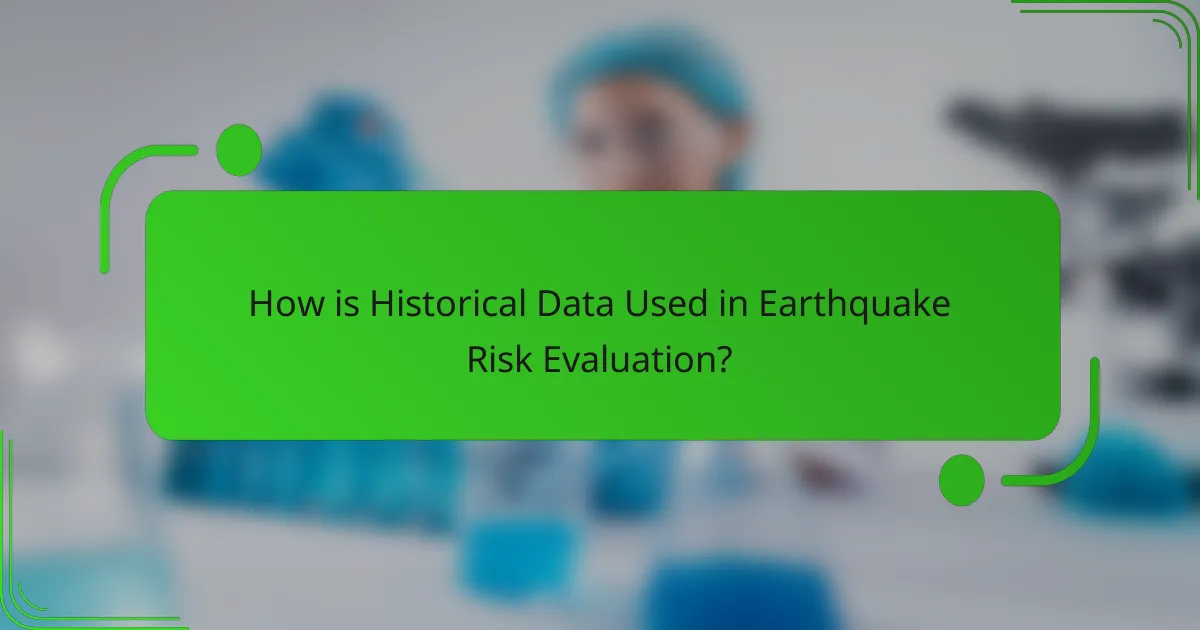
How is Historical Data Used in Earthquake Risk Evaluation?
Historical data is used in earthquake risk evaluation to analyze past seismic events. This data helps identify patterns in earthquake frequency and magnitude. Researchers utilize historical records to assess the likelihood of future quakes in specific regions. For example, areas with a history of significant earthquakes are deemed at higher risk. Historical data also aids in understanding the impact of past earthquakes on infrastructure and populations. By examining the damage caused by previous events, planners can improve building codes and emergency response strategies. Studies show that regions with comprehensive historical data can better predict and mitigate earthquake risks.
What types of historical data are relevant for earthquake risk assessment?
Relevant historical data for earthquake risk assessment includes seismic event records, geological data, and population density information. Seismic event records document the magnitude, location, and frequency of past earthquakes. Geological data provides insights into fault lines, soil composition, and tectonic plate movements. Population density information helps assess potential impacts on human life and infrastructure. Historical building codes reveal how structures were designed to withstand seismic forces. Insurance claims data indicate the economic impact of past earthquakes. Furthermore, historical accounts and reports can offer context on community responses and resilience. Collectively, these data types enable a comprehensive evaluation of earthquake risk.
How is seismic activity recorded over time?
Seismic activity is recorded over time through the use of seismographs. These instruments detect ground motion caused by seismic waves. Seismographs produce a continuous record known as a seismogram. The seismogram displays the amplitude and frequency of the seismic waves. Data is collected from various locations to create a comprehensive picture of seismic activity. This information is vital for understanding earthquake patterns. Historical records of seismic activity are maintained by organizations like the US Geological Survey. They analyze and archive this data for research and risk assessment.
What are the sources of historical earthquake data?
Historical earthquake data sources include geological surveys, academic research, and seismic monitoring networks. The United States Geological Survey (USGS) provides extensive earthquake catalogs. These catalogs document seismic events, including their magnitudes and locations. Additionally, regional seismic networks contribute localized data. Historical records from government agencies and universities also offer valuable insights. Academic publications often analyze past earthquakes for research purposes. International databases, such as the Global Centroid Moment Tensor (CMT) catalog, compile global seismic data. These sources collectively enhance understanding of earthquake patterns and risks.
How do past earthquakes influence current risk evaluations?
Past earthquakes significantly influence current risk evaluations by providing historical data on seismic activity. This historical data helps identify patterns and recurrence intervals of earthquakes in specific regions. For example, regions with frequent past earthquakes may be assessed as having a higher risk of future events. Additionally, the magnitude and impact of previous earthquakes inform building codes and preparedness strategies. Studies, such as the US Geological Survey’s assessments, utilize historical earthquake records to model potential future risks. This approach enables more accurate predictions of earthquake likelihood and potential damage. By analyzing past events, risk evaluations become more grounded in empirical evidence, leading to better-informed decisions.
What patterns can be identified from historical earthquake occurrences?
Patterns identified from historical earthquake occurrences include increased frequency along tectonic plate boundaries. Earthquakes tend to cluster in regions with past seismic activity. The majority of significant earthquakes occur in the Pacific Ring of Fire. Temporal patterns show that earthquakes can follow cycles of activity over decades. Magnitude and depth often correlate with specific geological features. For example, shallow earthquakes are more common near plate boundaries. Historical records indicate that certain areas are more prone to large earthquakes. Data from the US Geological Survey shows that 90% of earthquakes occur in less than 10% of the Earth’s surface. These patterns assist in assessing future earthquake risks.
How do historical magnitudes and frequencies inform predictions?
Historical magnitudes and frequencies inform predictions by providing a statistical basis for assessing future earthquake risks. Analyzing past earthquake data reveals patterns in magnitude and occurrence rates. For instance, regions with a history of significant seismic activity are more likely to experience future earthquakes of similar magnitudes.
Studies show that the recurrence interval of earthquakes can be estimated using historical records. The United States Geological Survey (USGS) indicates that the frequency of past earthquakes can help estimate the likelihood of future events. For example, if a specific area has experienced a magnitude 6.0 earthquake every 30 years, this historical frequency can guide predictions for future seismic events.
Additionally, historical data allows for the identification of trends in earthquake magnitudes over time. By examining these trends, scientists can refine their predictive models. The relationship between historical magnitudes and their frequencies enhances the accuracy of risk assessments and helps in developing effective preparedness strategies.
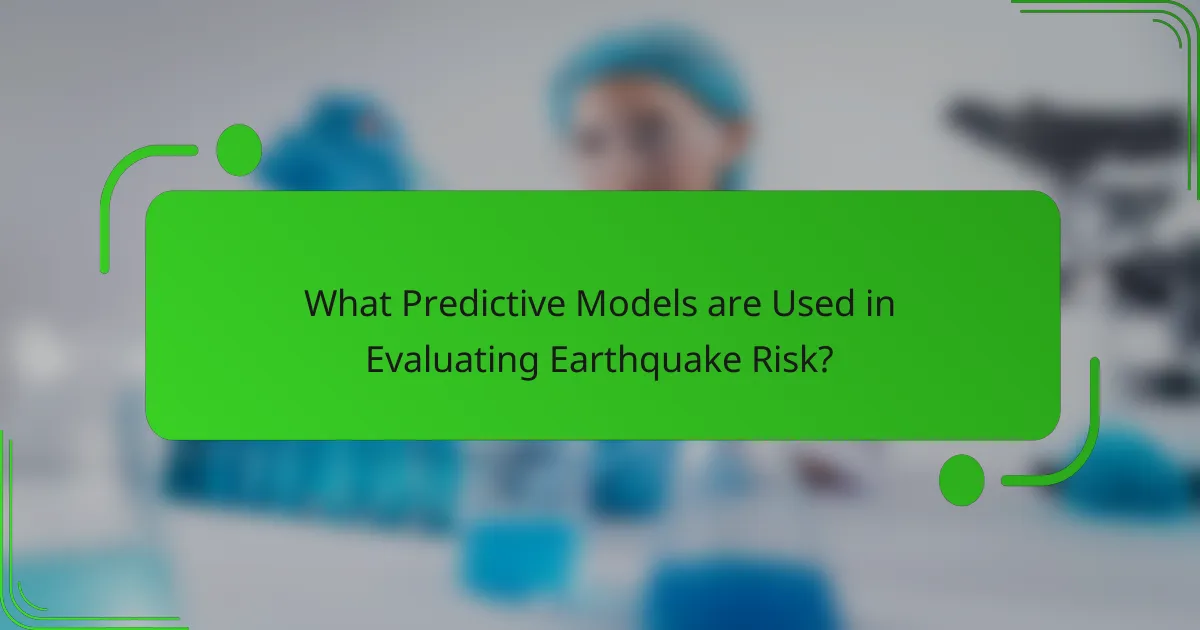
What Predictive Models are Used in Evaluating Earthquake Risk?
Statistical models, machine learning algorithms, and physical models are commonly used to evaluate earthquake risk. Statistical models analyze historical earthquake data to identify patterns and probabilities of future events. These models often utilize regression analysis to quantify relationships between seismic activity and geological factors. Machine learning algorithms can process large datasets to predict earthquake occurrences and magnitudes by recognizing complex patterns. Physical models simulate seismic waves and stress accumulation in fault lines, providing insights into potential earthquake scenarios. Each model type contributes unique insights, enhancing overall risk assessment accuracy.
What are the main types of predictive models for earthquake risk?
The main types of predictive models for earthquake risk are statistical models, physics-based models, and machine learning models. Statistical models analyze historical earthquake data to identify patterns and probabilities of future events. Physics-based models simulate the physical processes of earthquakes using geological and seismological data. Machine learning models utilize algorithms to learn from large datasets, improving predictions over time. Each model type contributes uniquely to understanding and estimating earthquake risks, enhancing preparedness and response strategies.
How do statistical models assess earthquake probabilities?
Statistical models assess earthquake probabilities by analyzing historical seismic data. These models utilize frequency and magnitude distributions of past earthquakes. They apply statistical techniques to estimate the likelihood of future seismic events. For instance, the Gutenberg-Richter law describes the relationship between the number of earthquakes and their magnitudes. Additionally, models may incorporate geological and tectonic factors to refine predictions. The U.S. Geological Survey employs such models for risk assessment. Historical data shows that regions with a high frequency of earthquakes have a higher probability of future events. Thus, statistical models provide a quantitative framework for understanding earthquake risks.
What is the role of computer simulations in earthquake risk prediction?
Computer simulations play a critical role in earthquake risk prediction. They model seismic activity and assess potential impacts on structures and populations. By simulating various earthquake scenarios, researchers can estimate ground shaking, fault behavior, and damage patterns. These simulations use historical data to refine their accuracy and predict future events. For instance, the ShakeMap system generates real-time ground shaking maps. This data helps emergency responders and policymakers prepare for potential earthquakes. Additionally, simulations support the design of earthquake-resistant buildings. They provide insights into how structures will perform under different seismic conditions. Overall, computer simulations enhance understanding and preparedness for earthquake risks.
How do predictive models integrate historical data?
Predictive models integrate historical data by analyzing past events to forecast future occurrences. They utilize statistical techniques to identify patterns and trends in historical data. This analysis helps in understanding the relationships between different variables. For example, in earthquake risk evaluation, historical seismic activity is examined. The models incorporate data such as magnitude, depth, and frequency of past earthquakes. Machine learning algorithms may also be applied to enhance predictive accuracy. These algorithms learn from historical data to improve their predictions over time. Thus, the integration of historical data is essential for developing reliable predictive models in earthquake risk assessment.
What methodologies are used to combine historical data with predictive analytics?
Methodologies used to combine historical data with predictive analytics include time series analysis, regression analysis, and machine learning techniques. Time series analysis examines historical data trends over time. It identifies patterns and seasonal variations, which can be crucial for predicting future events. Regression analysis establishes relationships between variables. This method helps in understanding how different factors influence earthquake occurrences based on historical data.
Machine learning techniques, such as decision trees and neural networks, analyze large datasets. They can uncover complex patterns that traditional methods might miss. These methodologies enhance predictive accuracy by leveraging historical data effectively. Studies show that integrating these approaches can significantly improve earthquake risk assessments and predictions. For instance, research published in the “Journal of Earthquake Engineering” illustrates successful applications of these methodologies in predicting seismic activity.
How do these integrations improve risk assessment accuracy?
Integrations improve risk assessment accuracy by combining diverse data sources. They enhance the predictive models used for assessing earthquake risk. Historical data provides context for understanding past events. Predictive models analyze patterns and trends in seismic activity. This combination leads to more comprehensive risk profiles. Enhanced data integration allows for real-time updates and adjustments. Improved accuracy in risk assessments helps in better preparedness and response strategies. Studies show that integrated approaches can reduce prediction errors significantly.
What best practices should be followed in earthquake risk evaluation?
Best practices in earthquake risk evaluation include conducting comprehensive hazard assessments. These assessments should analyze seismic activity in the region. Historical earthquake data is crucial for understanding potential risks. Utilizing predictive models can enhance risk evaluation accuracy. Engaging multidisciplinary teams ensures a thorough analysis of vulnerabilities. Regularly updating risk evaluations is necessary due to changing conditions. Incorporating community input fosters better preparedness and response strategies. Following building codes and regulations minimizes structural risks during seismic events.
How can communities effectively implement earthquake risk evaluations?
Communities can effectively implement earthquake risk evaluations by conducting comprehensive assessments of local seismic hazards. This involves identifying fault lines, soil types, and building vulnerabilities. Utilizing historical data can help predict future earthquake occurrences and impacts. Communities should engage local experts in geology and engineering for accurate evaluations. Regularly updating risk assessments ensures they reflect current conditions and advancements in predictive models. Educational programs can raise public awareness about earthquake preparedness. Collaboration with government agencies enhances resource availability and technical support. Research shows that communities with proactive risk evaluations can significantly reduce damage and casualties during earthquakes.
What tools and resources are available for accurate earthquake risk assessment?
Tools for accurate earthquake risk assessment include seismic hazard maps and ground motion prediction equations. Seismic hazard maps provide visual representations of earthquake risks in various regions. They are based on historical data and geological studies. Ground motion prediction equations estimate the expected ground shaking from potential earthquakes. These equations incorporate factors like distance from the fault and local soil conditions.
Resources such as the US Geological Survey (USGS) provide extensive data on earthquake history and risk assessments. The FEMA Earthquake Risk Assessment Toolkit offers methodologies for evaluating risks. Software like HAZUS helps simulate potential earthquake impacts on buildings and infrastructure.
Additionally, the Global Earthquake Model (GEM) provides a comprehensive framework for understanding global earthquake risk. Research studies, such as those published in the Journal of Seismology, validate these tools and resources by analyzing their effectiveness in risk assessment.
Evaluating Earthquake Risk is the systematic assessment of the potential impacts of seismic events on structures and populations. The article delves into the importance of earthquake risk evaluation, emphasizing the need for historical data and predictive models to identify vulnerabilities and inform disaster preparedness strategies. Key factors considered in this evaluation include geological conditions, building codes, and historical earthquake patterns. The use of statistical, physics-based, and machine learning models enhances the accuracy of predictions, ultimately contributing to improved safety measures and community resilience against earthquakes.

